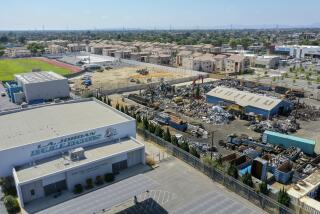After Plato Acid Leak : AQMD Seeks Curbs on Toxic Industry
Air pollution control officials announced last week that they are seeking legislation to prevent incidents such as a Jan. 7 acid leak from a metal-plating plant that sickened about 100 children at a neighboring San Dimas elementary school.
James Lents, executive officer of the South Coast Air Quality Management District, said his staff is preparing a bill that would prohibit factories that emit toxic air contaminants from locating near “sensitive receptors” such as schools, hospitals and convalescent homes.
Speaking at Wednesday night’s Bonita school board meeting, Lents said the need for such legislation became apparent during the last month as the AQMD and the school district sought to close Plato Products Inc.--the firm responsible for the acid leak--and found that they had no legal power to do so.
Because the land next to Arma J. Shull School was designated for industrial use and Plato met all other zoning standards, the City of Glendora permitted the firm to build its plant without requiring an environmental impact review or a vote by the City Council. Last month, Glendora Mayor Kenneth Prestesater said the city might face a lawsuit if it attempted to order the plant closed.
Plato eventually agreed voluntarily to cease metal-plating operations at the Glendora plant by Sept. 1. However, Lents said the air quality district does not want to have to depend on the cooperation of factory owners to avoid a recurrence of the Plato situation.
“The best way to deal with these problems is to prevent them in the first place,” Lents said.
Although the precise language of the legislation has not been decided, Lents said its intent would be to “outline a set of criteria that will not allow industries that are potential health hazards to locate near what we call ‘sensitive receptors.’ ”
Assemblywoman Maxine Waters (D-Los Angeles) plans to introduce a “spot bill” stating the intent of the legislation, said aide Stan Diorio. The measure must be submitted by Feb. 19 to be considered during this legislative session, he said.
Waters became interested in the issue after a 1986 incident in which a South Gate elementary school in her district had to be evacuated after toxic emissions escaped from a Purex Corp. plant, Diorio said.
Assemblywoman Sally Tanner (D-El Monte), who chairs the Assembly’s Environmental Safety and Toxic Materials Committee, said last week that she had not been asked by the AQMD to support the proposed measure. However, she said the idea of creating buffer zones between schools and factories is a good one.
“I would think that it would be received well in the Legislature,” Tanner said, adding that she would not expect business interests to lobby vigorously against such a bill. “One never knows, but I would think if they were responsible industries, they wouldn’t fight it.”
Gene Fisher, the AQMD’s intergovernmental affairs officer, said the AQMD staff and aides in Waters’ office are discussing how the bill should be worded to ensure its passage.
Most likely, the law would establish a minimum radius from sensitive areas within which certain types of factories could not locate, Fisher said. The bill probably would apply only to new industrial plants, though Fisher said the AQMD is also looking into ways to regulate existing factories.
“Certainly, the situation that exists now is unacceptable,” Fisher said.
Bonita school board member Sharon Scott, who spearheaded the school district’s campaign to shut down plating at the plant, said the kind of law envisioned by the AQMD would “help prevent the tragedy from happening to other schools.”
“There is already a consensus of real enthusiasm and support for this legislation and I have no doubt that the school board will support it,” she said.
Jeff Schenkel, who has led parents of children at Shull School in opposition to the plant since it opened in 1984, called the proposed legislation, “a step in the right direction.”
“It’s unfortunate that it took four years for the AQMD to get to this position,” said Schenkel, whose two children attend the school. “But if they’re willing to reverse themselves on this issue, I’m certainly willing to applaud them for it.”
Dr. Paul Papanek, chief of the county Department of Health Services’ toxics and epidemiology program, agreed that legislation regulating the placement of industrial pollution sources is long overdue.
“This issue of appropriate land use . . . (is) an issue we should have been smarter about in the past,” Papanek said. “But we haven’t been, and I think we’re just beginning to wake up to it.”
More to Read
Sign up for Essential California
The most important California stories and recommendations in your inbox every morning.
You may occasionally receive promotional content from the Los Angeles Times.










